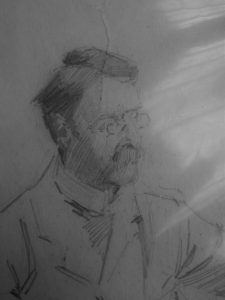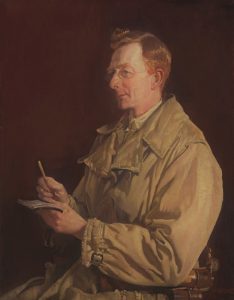- Author
- A.N. Other
- Subjects
- Biographies and personal histories, Naval Intelligence
- Tags
-
- RAN Ships
- None noted.
- Publication
- June 2016 edition of the Naval Historical Review (all rights reserved)
By Walter Burroughs
The Bean Connection
Most Australians interested in military history will have heard of Charles Bean, the war correspondent with a later responsibility for compiling and editing the Official History of Australia in the War of 1914 – 18. But Bean did not complete this epic twelve volume narrative on his own, with a number of others contributing. Volume IX in particular, concerning the Royal Australian Navy, is authored by Arthur Wilberforce Jose. While Bean continues to find adherents, who today knows anything of Jose, the man who helped define the image of the Royal Australian Navy?
Both Bean and Jose come from similar backgrounds so it is best to first acknowledge the formative years of Bean senior. After graduating from Oxford, 22 year old Edwin first came to the Colony of Tasmania 1873 where he was engaged as a tutor to the Travers family. Here he met Lucy Butler, the daughter of a prominent legal family, and they married in 1877. In 1874 he had become assistant classics master at Geelong Grammar School and the next year classics master at Sydney Grammar School. In 1878 he moved to Bathurst, becoming headmaster of an Anglican boys’ school All Saints’ College. Their first son Charles Edwin Woodrow Bean was born at Bathurst NSW on 18 November 1879.
Arthur Wilberforce Jose
Arthur Wilberforce Jose was born on 4 September 1863. The strange surname comes from early Spanish family ancestry before settlement as merchants in the West Country. Like Bean senior, his family was from Bristol and he was schooled at nearby Clifton College. At Clifton Jose was considered one of the most brilliant students of his time and not unexpectedly won a prestigious scholarship to Oxford’s Balliol College. After only one year at university the youngster’s health broke down and for recuperation a warmer climate was recommended with a trip to Australia, where he arrived in 1882. While here he learnt that his father had lost his fortune, making it impossible for him to resume studies at Oxford. He was offered a clerical position but turned this down and instead chose to go bush, taking odd jobs with the outdoor work improving his health and gaining new experience in the exciting environment. He became an early backpacker, moving from place to place taking employment timber cutting, road mending, camp cooking, fruit picking and as a fencing contractor, but always taking notes for later use in chronicling his travels.

When he reached Tasmania Jose, much like Edwin had done some years earlier, obtained a position as tutor to a local family. While here he met the Reverend Eric Bean (1), who was holidaying with his wife’s family. Bean offered Jose a position as assistant master at his school, All Saints’ College, Bathurst. Jose remained here from 1885 until 1888.
He next gained a position as an extension lecturer at the University of Sydney. At this time he published his first book of poems under the pen name Ishmael Dare (2). His first major work, The Growth of Empire,was published in 1897 and A Short History of Australasia appeared in 1899; it ran to fifteen editions, becoming a recognised school textbook. It is assumed that Jose, who was most likely reading at Oxford for double degrees in Arts and Civil Law, may have been granted some academic standing as he was granted admission to the NSW Bar in 1891, although he never practised. In 1892 the University of Sydney formally established an Extension Board, with the aim of providing educational opportunities – particularly through evening tutorial classes – to working men and women. In addition to part-time lecturing Jose became Secretary of this Board and in 1893, without formal qualification, Jose also became a temporary lecturer in modern literature at the University proper.
Jose was a close friend of the celebrated painter, and later official war artist, George Washington Lambert and the two men married sisters. Jose’s next book Two Awheel was illustrated by Lambert. One of Lambert’s earliest works is an 1895 pencil sketch of Arthur Jose which is held by the State Library of NSW; he also later, in 1924, painted a better known portrait of Charles Bean which is held by the Australian War Memorial. Possibly the Jose sketch was preliminary to a never commissioned portrait.
Relationship with Charles Bean

With his health restored the bright and dashing young Arthur Jose was a great attribute to All Saints’. While Arthur was 16 years senior to Charles Bean they struck up an instant rapport which developed into a close friendship, lasting the test of time. The two were separated in 1899 when the Beans returned to England where Edwin had been offered a headship at another school and considered he would be better placed to educate his growing family. Charles followed his father as a boarder at Clifton before going up to Oxford. The more worldly-wise Arthur Jose was now making his name as an author and journalist.
Jose’s Career Blossoms
In the early years of the Second Boer War (1899-1902) Jose travelled to South Africa where he worked as a war correspondent. He then returned to England and in 1902 accepted the post as acting professor of English and History at the Mohammedan Anglo-Oriental College, Aligarh in India. Two years later he returned to Australia as the resident correspondent of the London Timesand retained the position until early 1915. In November 1905 he married Evelyn Agnes Absell; her sister Amelia was married to Lambert.
He became an intimate of Alfred Deakin, who not unlike Jose was a barrister and journalist before becoming a politician, serving as Prime Minister on three occasions between 1903 and 1910. Many of Jose’s weekly letters to The Timesalmost certainly represented Deakin’s views. Through these authoritive despatches the new Dominion obtained considerable publicity in Whitehall.
Jose’s Naval Service
Before the start of the war, in mid 1914, Jose entered the Australian Army Intelligence Corps with the rank of Probationary Lieutenant and was later promoted to Captain. A few months after the outbreak of war he was employed in the Intelligence Branch of the Royal Australian Navy. Here he was mainly engaged in political analysis and was able to observe the workings of the department, enabling him to write his official history and the part played by the RAN.
Jose’s relationship with the Australian Naval Board was fraught with issues of censorship and the views expressed by the author were often seen as detrimental to the navy and senior personnel. The RAN placed its ships under the command of the Royal Navy during the war and there were further concerns of upsetting Dominion and Imperial relationships, including those with the Japanese. Jose was convinced this was mainly a personality clash as most of the Naval Board were either from the RN or ex-RN and had limited operational experience of the Australia Station. Charles Bean, who had overall responsibility for the War History, was obliged to intervene and found it difficult to understand what all the fuss was about when the other volumes, mainly concerning the prominent Army involvement, were preceding smoothly.
Eventually a compromise was reached when in late 1921 the Navy Ministry was abolished and absorbed into the Ministry for Defence. Defence Minister Senator George Pearce took a more practical approach, overriding many of the Naval Board’s objections to Jose’s proposed drafts. It is unfortunate that in late 1920 Jose took on the role of editor-in-chief of The Australian Encyclopaedia and was also writing other histories. This level of work could and did lead to conflict in the amount of time he could devote to the official war history.
According to the Preface of Volume IX of the Official History this was completed by Jose on Armistice Day (11 November) 1926. But the first edition of this volume was not published until 1928. Underneath the Preface there is a footnote which reads:
The emergence – from British, French, and German sources – of certain data which, unfortunately, were not available to the author (who is now in Europe), has rendered additional revision necessary. This has been effected with as little alteration as possible, whether of the narrative or of the views expressed, but not without delay.
It therefore appears that Charles Bean as editor took considerable personal interest in smoothing his friend’s work and ensuring this volume did not ruffle any more feathers.
With, as far as he was concerned, his war history completed the Jose family went to Europe and remained there for five years. He spent a year in France making a close study of the Archives Nationales, particularly the diaries of the famous navigator Nicolas Baudin who led an expedition to the Great South Land in 1800 – 1803. While overseas Jose reviewed numerous Australian books for The Times Literary Supplement.
A younger brother George Herbert Jose also attended Clifton and won an Oxford scholarship; he became a missionary and married an Australian. They eventually settled in Adelaide where George became a parish priest. He was a chaplain in the AIF during WWI.
In Memory of Arthur Jose and His Contribution to the RAN
Arthur and Evelyn Jose returned to Australia in 1933 and settled in Queensland. The next year, at the age of 70, he died in Brisbane following an operation for peritonitis.
Jose was a fine classical scholar who was well known and respected by most Australian parliamentary leaders of the immediate post-federation and First World War eras. He felt at home in his adopted country and developed quite independent and nationalistic views. He could fearlessly put forward an argument which was always favourable to an Australian outcome. However his forthright manner undoubtedly upset some conservative senior naval officers. While he maintained a military bearing and could at times appear aloof, he could relax with sport and music and be an entertaining companion.
The Royal Australian Navy shall forever be indebted to Jose for his great volume on the history of the RAN during the war of 1914 to 1918. This work demonstrates that during the war years the RAN had justified the faith placed in it by the founding fathers, both naval and political leaders, including such men as Alfred Deakin. Whether fighting in action, in routine patrols or working ashore, the new Australian fleet and its men had showed themselves capable and worthy successors to a proud naval heritage adopted from afar. Arthur Wilberforce Jose helped explain the part played by the ships and men of the Royal Australian Navy in defining the strong naval traditions that remain evident to this day.
Notes
- Bean (senior) is often referred to as the Reverend Edwin Bean. When he returned to England in 1889 Edwin Bean took up the headmastership of Brentwood School in Essex here he became a church deacon and was ordained in 1897. On retirement in 1913 the Beans returned to Hobart to be closer to Lucy’s family here in a part-time capacity Edwin also taught at the local grammar school and served as a parish priest.
- Using the pseudonym Ishmael Dare the author is teasing his readers. The forename is of self-realisation with Ishmael, the firstborn of Abraham being cast aside in favour of a younger brother and, the surname of J’ose is the French for ‘I dare’.




